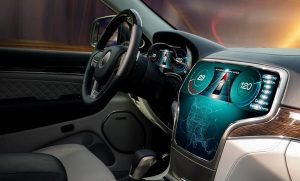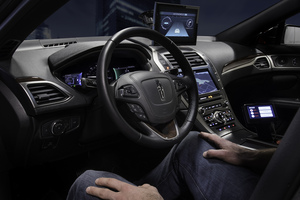Data is central to the automotive development process. Without data, self-driving cars, electric vehicles and the infrastructure that has helped to build them would not be actualised.
Sure, data has the ability to drive change, says Joerg Zimmer, VP EMEA sales, BlackBerry Technology Solutions, the division of BlackBerry that includes the QNX product portfolio. But what are the specific areas it will transform mobility in? Below, he shares seven of the ripest for innovation.
- Customer care
Customer experience (CX) is fast becoming the largest differentiator between brands in any industry. It’s no different for the automotive sector. Yet, it can’t be done in halves simply because of the historically impersonal relationship between automaker and driver. In a modern world of perfect, algorithmically-generated experiences from Netflix, Uber and the like, automakers have their work cut out to effectively capitalise on the wealth of data gleaned from the newfound connectivity of their vehicles.
The answer lies in capturing the data behind customer interactions and acting upon what is learned. With this information behind the cause and timing of customer problems, the automaker could introduce “moments of delight” by fixing issues in real time or proactively offering solutions anything from streamlining vehicle servicing to intuitively suggesting parking spots. This continuously improves CX by stopping potential customer frustration in its tracks. The same platforms that use this data can also keep it safe from hacks. This balance between using data flexibly, and keeping it safe, builds up the relationship of long-term trust with the vehicle user.
2. In-vehicle applications
Customers also have the opportunity to seize the potential of their car’s data by customising their drive through automotive apps.
For automakers, this means the complexity of an app ecosystem within the vehicle. Building a standardised and stable in-vehicle application platform and attracting a developer community are lengthy and costly processes with high risk.
However, with a safe, broad ecosystem in place, a diverse group of developers from automakers, suppliers and third parties can all work their magic to create brilliant apps, whether they have automotive experience or not. To top it off, if the customer has multiple vehicles from different brands, the same apps can be used across them if all vehicle-independent service portability is in place.
3. Electric cars
One of the biggest consumer worries with electric cars as their mileage slowly increases, is the fear of being stranded far from a charging point. However, by capturing usability and navigation data, automakers can discover where to put charging points, how much capacity they’ll need, and how to let drivers know about them.
By capturing usability and navigation data from thousands of drivers, automakers can understand how to best keep their customers happy through predictive maintenance services. This could manifest itself in offering customers advance warning of when to rotate tires, change bulbs, top up lubricants, or replace batteries.
Looking at the bigger picture of society’s electrical infrastructure, automakers can also analyse the data of individual usage patterns to help optimally distribute car charging cycles, helping utility companies cope with larger loads on the power grid introduced by sizable numbers of EVs being charged overnight.
4. Ubiquitous data
Although autonomous, electrification and CX programs are all aided by data-driven processes and analysis, the systematic creation, collection, and organisation of this underlying data by automakers is a trend in itself. Automotive big data is an invaluable tool for automaker analysis.
Through the data they provide, connected cars enable analytics to understand where to open new dealerships or service centres, as well as a host of other business-critical decisions. It could even be sold to governments or business franchises who want to understand vehicle routes or locations.
Yet, storing these huge amounts of data is costly. Automakers need to manage it effectively, by ensuring the data from older vehicles can be blended with modern data for easier analysis, and also through intelligence at the edge. To sift the raw data as it’s generated makes much better use of bandwidth, offering very real financial and ecological benefits.
5. On-demand mobility
Buying a car offers freedom of mobility, sure but it comes with huge costs. Yet, today, it’s possible to purchase mobility without buying a car. Mobility-as-a-service (MaaS) offers pay-per-ride, pay-per-day, short-term contractless rentals, subscriptions and other innovative business models that start-ups are seizing.
Data will be the key to the MaaS industry booming on the main automotive stage. By determining the patterns that underlie the use of shared vehicle assets (such as usage patterns, sharing hot-spots and information that guides timing- and capacity-based pricing), automakers can maintain the perfect balance between service and ownership-oriented transportation options.
In addition, when it comes to MaaS in the city, automakers can provide detailed information about traffic flows without the costly camera or road surface infrastructure, paving the way for how MaaS will reroute the vehicular lifeblood of a city.
6. Securing your cyber defence
The reliance of modern vehicles upon software is great news not only for drivers seeking modern experiences, but also for cybercriminals. The more software, the more there is to hack. Compromised vehicles could be unthinkably dangerous so prevention of such attacks is paramount.

Automakers must be conscious of four critical factors in their cybersecurity approach, securing vehicle software, securing cloud infrastructure, recognising vulnerabilities, and patching vulnerabilities.
But how does a security team recognise vulnerabilities that have never been seen before (zero-day exploits)? Continuous monitoring of vehicle activity gives systems a chance to spot anomalous behaviours, which could reveal software vulnerabilities that are then quickly patched. Equally, teams could act on real-time intelligence provided by cybersecurity experts, before speedily disabling the vehicle’s software remotely, to prevent any further reverse engineering by the cyber attackers.
7. Driverless cars
It’s fair to say that the entire automotive industry is working towards the goal of autonomous vehicles. While Level 5 vehicles (as defined by the Society of Automotive Engineers) are still further away we are on a good track with adding partly autonomous functions that will eventually lead to Level 5.
Data is at the heart of this pursuit, put to work to train self-driving algorithms by “showing” the car potential situations and “teaching” it to react in certain ways. But to make the vehicle’s performance consistently reliable, this training process must have access to a huge amount of driving data captured under a wide variety of conditions.
This data includes raw sensor data (which captures the car in its environment), vehicle data (which comes from internal status updates), and metadata. The latter looks at the first two data streams and assigns labels which give them human-level meaning. This complex system is decipherable by automakers through advanced processing that produces analytical insights into how the autonomous system is coping, and where it could make improvements. Machine learning can also add new synthetic sensors, to generate new insights on any number of autonomous events, from understanding speed limit sights to seeing in low visibility.
The link: data points and the limitless future

With the amount of valuable data cars generate today, the future of mobility is limitless. However, it doesn’t mean automakers will automatically pioneer the future of mobility. Data technologies, vehicle software and security will be vital to stay on top and ahead of industry trends.
The earlier they become acquainted with integrating data in steering innovation in motors the more benefits they reap. To discover more, please visit here.
The author is Joerg Zimmer,VP EMEA sales, BlackBerry Technology Solutions.
Comment on this article below or via Twitter: @IoTNow_OR @jcIoTnow










